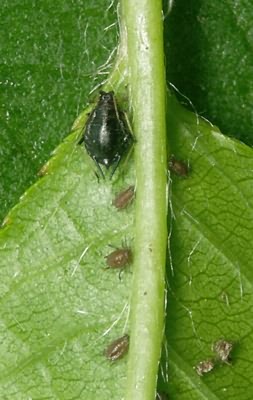Pests
Myzus cerasi F. - Black Cherry Aphid
Systematic position.
Class Insecta, order Homoptera, suborder Aphidinea, superfamily Aphidoidea, family Aphididae, subfamily Aphidinae, tribe Macrosiphini, subtribe Macrosiphina, genus Myzus.Biological group.
Oligophagous pest of stone fruit trees.Morphology and biology.
The body of apterous female is wide, pear-like, shiny, black from above and brown from below. Its length varies from 2 to 4 mm. Dark green 6-segmented antenna is about half as long as body. Black cylindrical siphunculi narrowing toward apex are 2.5 times as long as fingerlike tail. Wide tubercles on antenna form frontal furrow. Winged female is shiny black; its length reaches to 2.4 mm. Oval eggs are black. The overwintering takes place at the phase of egg. Eggs are located one by one at bud basis on young cherry trees. Hatching of fundatrix larvae in the zone of strong harmfulness is observed in April during the swelling of fruit buds. The insects prefer lower side of upper leaves on young trees; on older trees, the pest feeds on lower leaves and young shoots at roots. The Aphid also feeds on fruit stalks. The insects suck out sap of the veins; leaves fall behind in their growth, become twisted, then black and dry. The species is facultative migrant, having secondary host-weeds of the genera Galium, Veronica, Euphrasia, Bidens. Larval period lasts 6-10 days. Life span of apterous parthenogenetic female is 20-52 days (depending on zone); its fecundity varies from 60 to 120 larvae. Virginoparae appear in September. In October, the female lays eggs by 3-5 on cherry-trees near buds. Oviposition continues until leaf fall and frosts below -10°C.Distribution.
Species is spread in Europe; Anterior and Middle Asia; North America, North Africa, Australia. Within the territory of the Former USSR, the species occurs widely in the zone of cherry tree growing. Its highest harmful activity is reported in steppe zones of Ukraine, in Lower Volga Basin region, Moldova, Middle Asia, Kazakhstan (mainly in southern regions), North Caucasus, Transcaucasia.Ecology.
The hatching of fundatrix larvae is observed at the degree day sum 43.6-60.9°C. In high damage zone, the largest number of aphids appears in May-June. In July-August the pest slows down its development, reducing fecundity because of hot temperatures and plant hardening. The most favorable conditions for apterous females are temperatures 25-28°C and relative humidity 70-80%. Virginoparae appear at the degree day sum for the last week 50-70°C and daylight period 14-15 hours. The pest gives 10-16 generations during a year. Most important predators are: Anthocoris nemorum L., Forficula auricularia L., Adalia bipunctata L., Propylaea 14-punctata L., Coccinella septempunctata L., C. quinquepunctata L., Adonia variegata Goeze, Chrysopa perla L., Ch. carnea Steph., Syrphus corollae F., S. balteatus Deg., S. ribesii L., Ephedrus persicae Frogg., E. plagiator N., E. cerasicola Stary, Praon volucre Hal.Economic significance.
The species is oligophagous. It damages cherry, plum, apricot and peach trees. Insects feed on Galium mollugo L., G. aparine L., Euphrasia stricta Wolff., Veronica officinalis L., Odontites verna Rchb. Damaged leaves become yellow and twisted. Yield may be reduced by 30%. Control measures include forecasting pest appearance and numbers, eradication of weeds, insecticide treatments in May-June.Reference citations:
Abashidze A.T. & Gvishiani D.K. 1973. Some dates on black cherry aphid study. In: Kanchaveli L.A., ed. Proceedings of Georgian NIIZR, N XXIV. Tbilisi: Georgian NIIZR. 94 p. (in Russian).Gilmore J.E. 1960. Biology of the Black Cherry Aphid in the Willamette Valley, Oregon. Journal of Economic Entomology 53(4): 659-661 p.
Ivanovskaya O.I. 1976. Fauna of aphids on the territory of West Siberia. In: Zolotorenko G.S., ed. Fauna of helminthes and arthropods of Siberia. Novosibirsk: Nauka. P. 175-189 (in Russian).
Ivanovskaya, O.I. & Kupyanskaya, A.N. 1979. The aphids (Homoptera, Aphididae) damaging trees and bushes in Primorskii Territory. In: Ivliev L.A., ed. Ecology and biology of arthropods in the southern Far East. Vladivostok: Izd. AN SSSR. 50 p. (in Russian).
Kosov V.V., Polyakov I.Ya., ed. 1958. Forecasting and calculation of pests and diseases on agricultural cultures. Moscow: Agricultural Department. 455 p. (in Russian).
Nevskii V.P. 1929. Aphids of Middle Asia. Proceedings of Uzbekistan Experimental plant protection station 16. Tashkent. 272 p. (in Russian).
Racauskas R.P. 1984. Biology and ecology of black cherry aphid in Lithuanian SSR. In: Petrauskas V., ed. Proceedings of AN Lithuanian SSR. Vol. 4(88). Vilnius: AN Lithuanian SSR. 80-88 (in Russian).
Shaposhnikov G.Kh. 1964. Order Homoptera. In: Kryzhanovskii O.L., ed. Insects and mites - pests of agricultural crops. V. 1. Leningrad: Nauka. P. 598 (in Russian).
Vereshchagina V.V. 1966. Black cherry aphid Myzus cerasi Fabr. on cherry trees and control measures in Moldova. In: Talitskii V.I., ed. Proceedings of Moldavian Institute of gardening, viniculture, and winemaking. V. 13. Kishinev: Kartya Moldovenyaske. 53-57 p. (in Russian).
Vereshchagina V.V., Vereshchagin B.V. 1966. Aphids of stone fruit trees in Moldova and its diagnostics. . In: Talitskii V.I., ed. Proceedings of Moldavian Institute of gardening, viniculture, and winemaking. V. 13. Kishinev: Kartya Moldovenyaske. 39-52 p. (in Russian).
Vasil.ev V.P., ed. 1973. Pests of agricultural crops and forest plantations. 1. Kiev: Urozhai. 299-300 p. (in Russian).
Zhemchuzhina A.A. & Stenina N.P. 2001. Control in garden and kitchen-garden against pests and diseases. St.Petersburg: Mim-Del'ta. 659-661 p. (in Russian).


